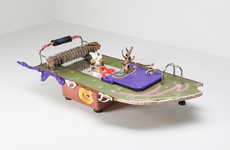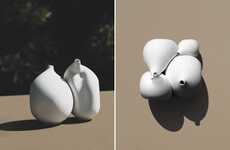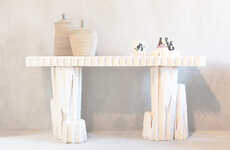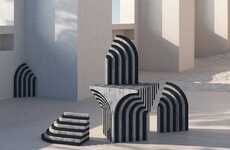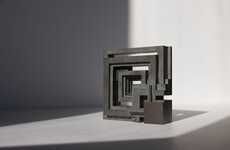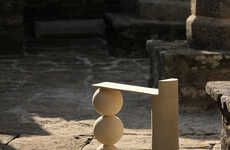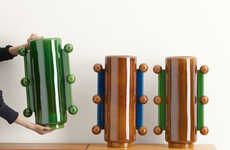
Philipp Schenk-Mischke Designs Process Plug-Ins, Vases and Tables
Amy Duong — July 31, 2018 — Art & Design
Philipp Schenk-Mischke is a graduate from the Royal College of Art and his latest project is the Process Plug-Ins. This includes a range of lopsided ceramic and furniture pieces that are designed to look accidental in its visual design as they are held up using metal blobs. The pieces aim to interfere with the traditional ways of manufacturing, going down a more random route. The young designer personally wanted to reflect his own experience as a designer in a post-internet culture. The name of the project recalls web design as adjustability and hacking opportunities can easily interfere.
The ceramic vases are called BTM Ceramics and they feature a colorful blend of colors and imperfect details. The folds are made using a vibrating plate to distort the material in a random structure. The furniture pieces are called Primitive Fixings, featuring a table and a bookshelf using slabs of marble and aluminum.
The ceramic vases are called BTM Ceramics and they feature a colorful blend of colors and imperfect details. The folds are made using a vibrating plate to distort the material in a random structure. The furniture pieces are called Primitive Fixings, featuring a table and a bookshelf using slabs of marble and aluminum.
Trend Themes
1. Accidental-motif Design - Designers are intentionally creating pieces with a visually accidental aesthetic, disrupting traditional manufacturing methods.
2. Lopsided Ceramic and Furniture Pieces - Ceramic and furniture pieces are being designed with intentionally asymmetrical shapes, challenging traditional design norms.
3. Imperfect Details and Random Structures - Designers are incorporating imperfections and random structures into their creations, embracing uniqueness and irregularity.
Industry Implications
1. Art and Design - Artists and designers can explore the trend of accidental-motif design to create visually intriguing and disruptive pieces.
2. Home Decor - The home decor industry can tap into the lopsided ceramic and furniture trend to offer unique and unconventional products to consumers.
3. Manufacturing - Manufacturing companies can adapt to the trend of imperfect details and random structures by introducing innovative production techniques to create visually distinctive products.
0.7
Score
Popularity
Activity
Freshness


